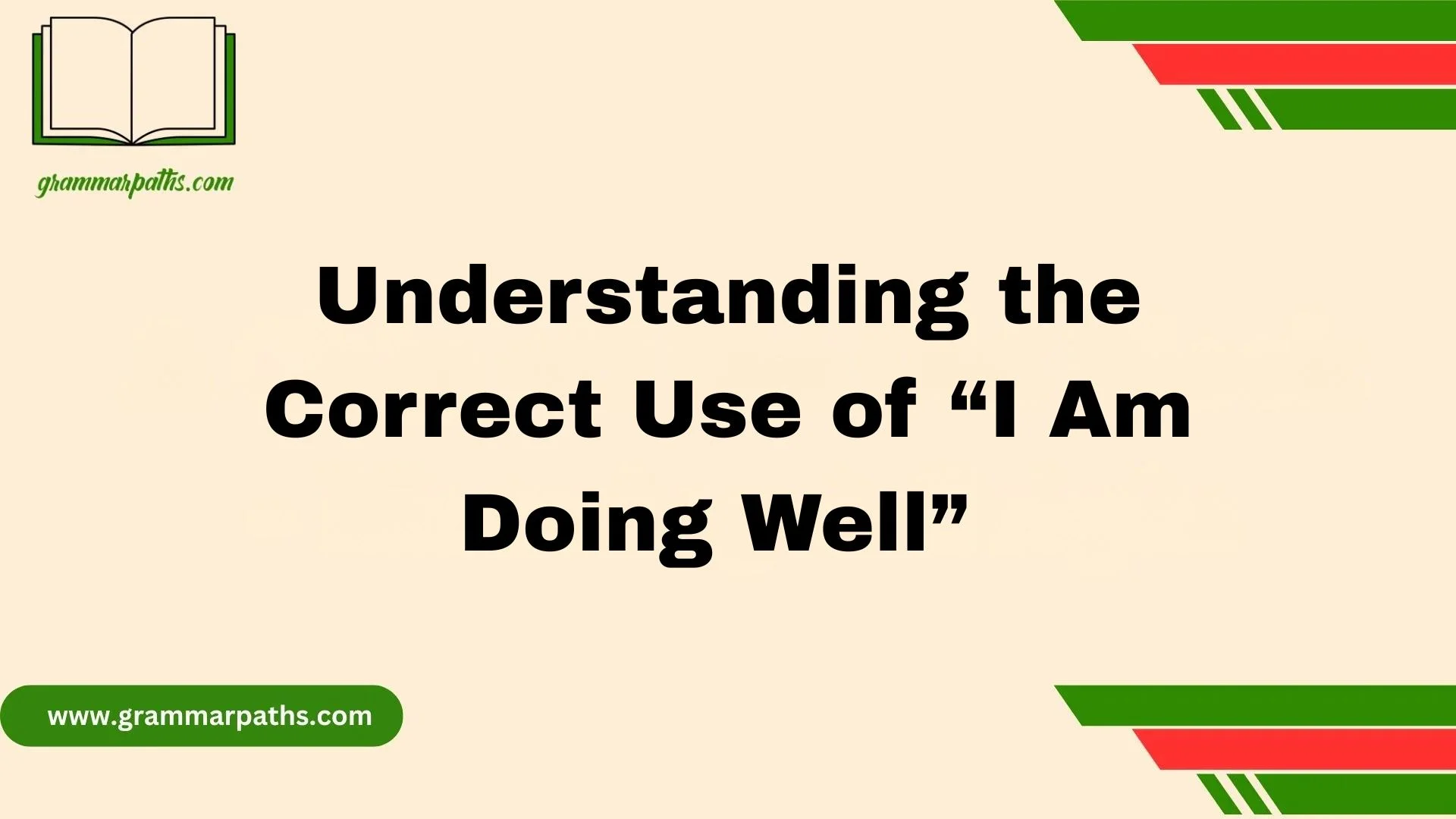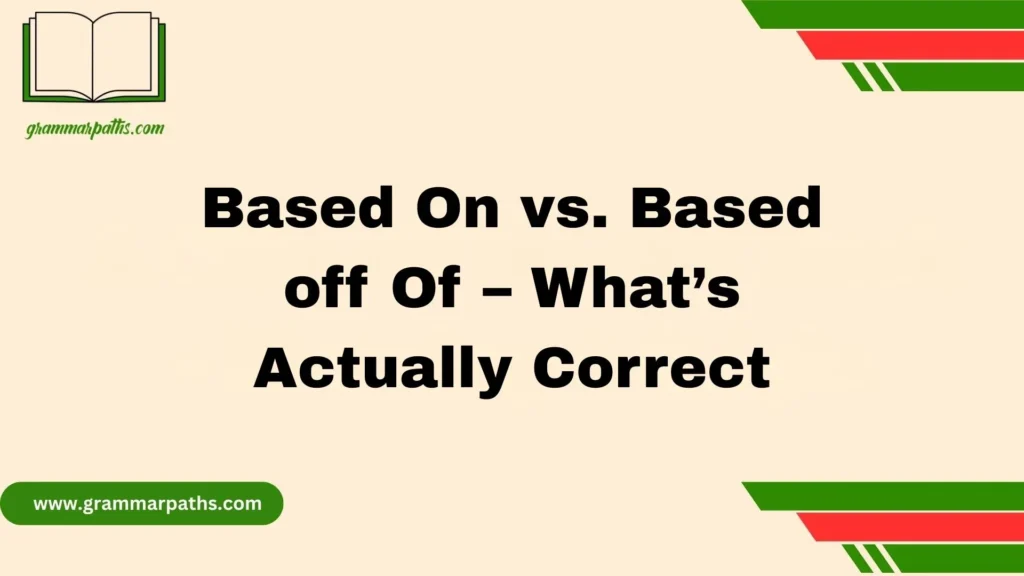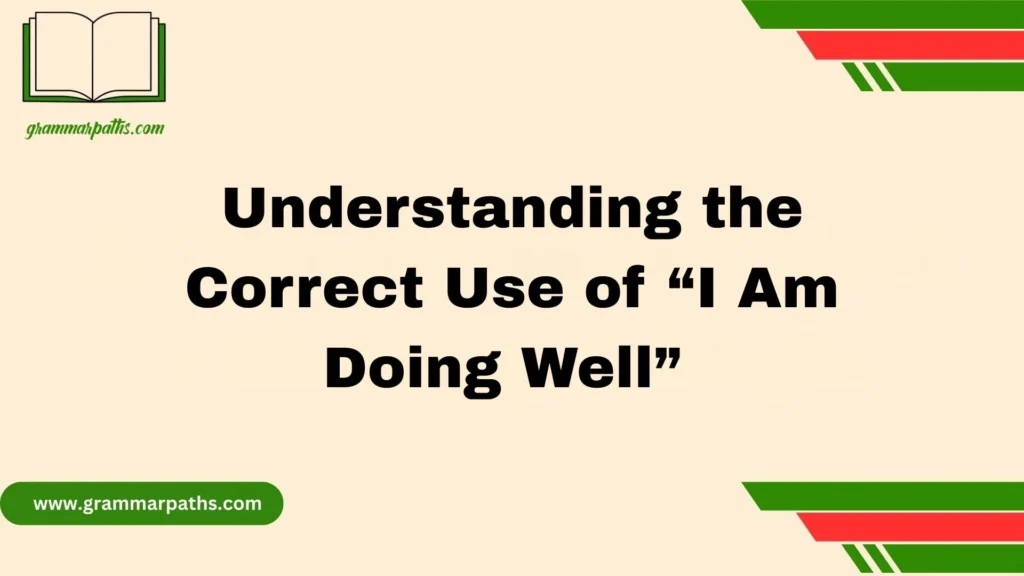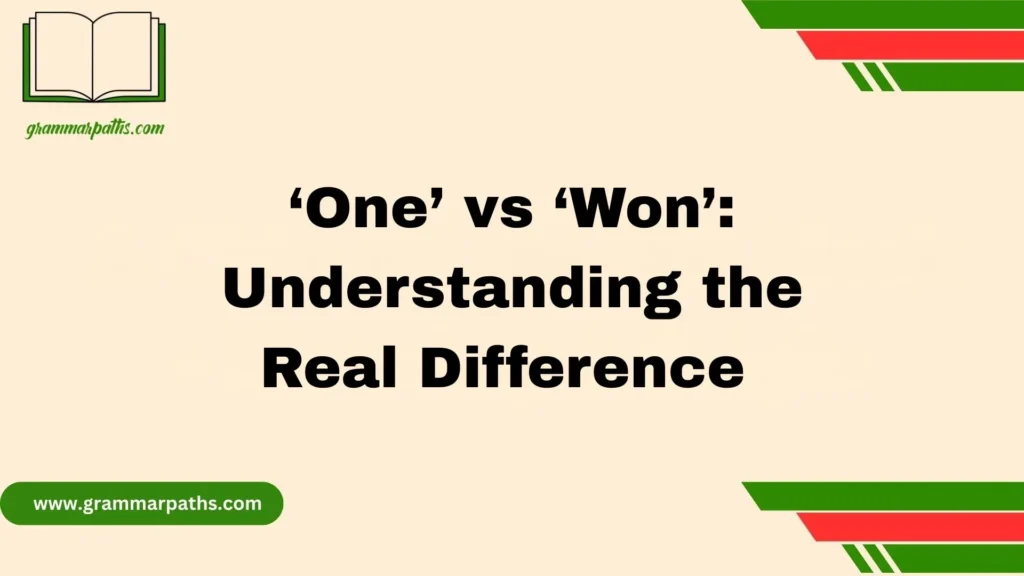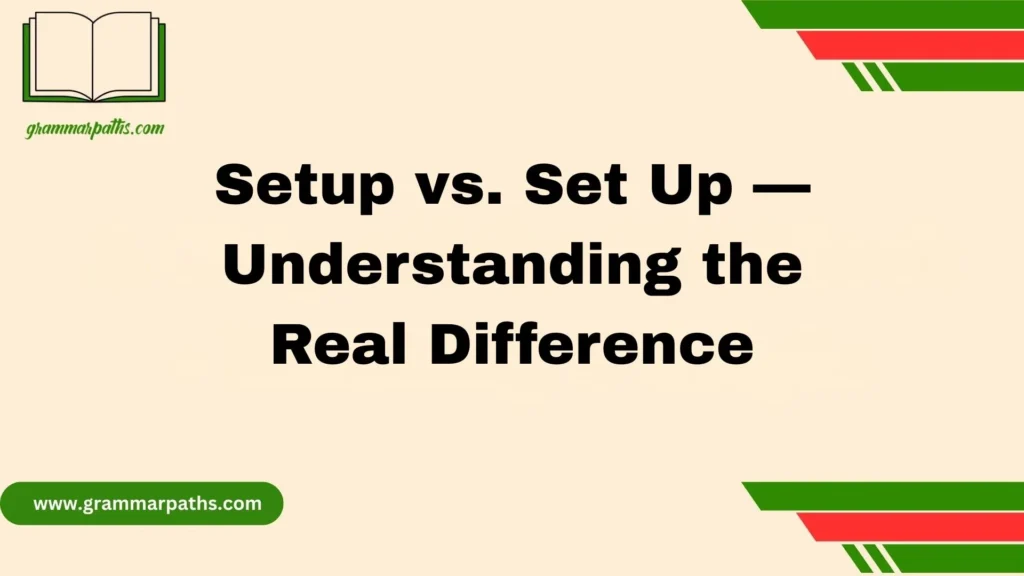In everyday American English, phrases like “I am doing well” and “I am doing good” often cause confusion. While both are commonly used in casual conversations, there’s a subtle difference in grammar and meaning that’s worth understanding. The phrase “I am doing well” is the grammatically correct form because “well” functions as an adverb describing how you’re doing, while “good” is an adjective used to describe nouns, not actions.
In formal or professional settings, saying “I am doing well” shows a good grasp of proper English grammar and sounds more polished. However, in informal American conversations, many people say “I’m doing good”, especially when speaking casually among friends or family. Understanding this distinction helps improve spoken English fluency, grammar accuracy, and communication confidence.
Whether you’re writing an email, introducing yourself in an interview, or simply chatting, knowing when to use “I am doing well” versus “I am doing good” makes a noticeable difference. It not only reflects your command of English language nuances but also helps you sound more natural and articulate in any American English context.
In this guide, we’ll break down what “I am doing well” really means, when to use it, and how it compares to “I am good.” You’ll learn the grammar behind good vs. well, discover cultural nuances, and pick up natural alternatives for different situations — from casual chats to professional greetings.
Breaking Down the Phrase “I Am Doing Well”
To understand why Americans often say “I’m doing well,” let’s look at its structure.
“I am doing well” consists of:
- I → the subject
- am doing → the verb phrase (present continuous form of “do”)
- well → an adverb describing how you’re doing
In this context, “doing well” means you’re in a good state or things are going positively for you. It doesn’t refer to a specific action but rather your overall condition — emotionally, physically, or situationally.
For example:
- “I’m doing well at my new job.” → You’re performing successfully.
- “I’m doing well today.” → You’re feeling positive overall.
- “I’m doing well after the surgery.” → You’re recovering nicely.
Quick Tip: When you say “I’m doing well,” you’re describing your state of being, not your moral goodness. That’s what separates it from “I’m good.”
Good vs. Well: The Grammar Explained Simply
Many people confuse “good” and “well” because both can describe positive states. However, in English grammar, their roles differ.
Good
- Part of speech: Adjective
- Function: Describes nouns
- Example: “She’s a good friend.” → “Good” describes friend.
Well
- Part of speech: Usually an adverb, sometimes an adjective
- Function: Describes verbs or sometimes nouns (especially related to health)
- Example: “She sings well.” → “Well” describes how she sings.
But when you use linking verbs like am, is, are, the rule changes. Linking verbs connect the subject to a state of being, not an action.
So:
- “I am good” → describes you as a person (adjective).
- “I am well” → describes your health or condition (adjective form of “well”).
Here’s a quick reference table to help:
| Sentence | Correct Form | Why It’s Correct |
| She sings ___ | well | Describes how she sings (adverb) |
| She is ___ | good | Describes what kind of person she is (adjective) |
| I am ___ | well | Describes your health or condition |
| I am ___ | good | Describes your general state, more casual |
In conversation, Americans often use both forms interchangeably because spoken English prioritizes meaning and tone over strict grammar.
Why “I Am Good” and “I Am Well” Are Both Acceptable
The truth is, both are correct — it just depends on where and how you use them.
- “I’m good” → informal, friendly, and very common in the US.
- “I’m well” → grammatically precise, polite, and slightly more formal.
- “I’m doing well” → natural, balanced, and fits in both casual and professional settings.
Context Examples
| Setting | Natural Response | Explanation |
| Formal meeting | “I’m doing well, thank you for asking.” | Polite and professional |
| Talking to a friend | “I’m good! How about you?” | Friendly and informal |
| Job interview | “I’m doing well today, thanks.” | Confident and composed |
| Email to a client | “I hope you’re doing well.” | Courteous and professional tone |
Americans appreciate friendly yet polished responses. “I’m doing well” achieves that balance — it’s polite but not overly stiff.
The Cultural Side of “How Are You?” in American English
If you’ve lived or worked in the U.S., you’ve probably noticed that “How are you?” isn’t always a genuine inquiry into your wellbeing. It’s often used as a social greeting, similar to saying “Hello.”
In American culture:
- The question “How are you?” is a ritual greeting, not an invitation to share personal problems.
- The expected answer is short, positive, and upbeat.
- Overly negative responses can make the other person uncomfortable in casual exchanges.
For example:
- “Hey, how are you?” → “I’m doing well, thanks!” (Typical response)
- “I’ve been sick all week and my car broke down.” → Feels overly detailed for small talk.
This doesn’t mean Americans are insincere — it’s just part of cultural politeness. It helps keep interactions friendly, light, and socially smooth.
Politeness, Warmth, and Social Etiquette
Language reflects more than grammar; it shows emotional intelligence. When someone says “How are you?” your response helps set the tone of the conversation.
When to Use “I’m Doing Well”
- Professional settings: When talking to supervisors, clients, or colleagues.
Example: “I’m doing well, and I appreciate you asking.” - Public speaking: Starting a presentation or interview.
Example: “I’m doing well and excited to be here.” - Polite replies: When you want to show gratitude or respect.
Example: “I’m doing well, thank you. How about yourself?”
When to Use “I’m Good”
- Casual chats: Friends, family, peers.
Example: “I’m good! You?” - Relaxed environments: Coffee shops, gyms, informal calls.
Example: “Hey, I’m good — just finishing up work.”
Being aware of tone and context helps you build rapport naturally.
The Psychology Behind “Doing Well”
Saying “I’m doing well” carries a subtle psychological effect. It projects confidence, optimism, and control.
- It tells people you’re handling life’s challenges positively.
- It creates a calm, reassuring presence in professional situations.
- It reflects emotional balance, which people subconsciously trust.
In American workplaces, this kind of phrasing can even influence perception. People who answer confidently often come across as composed and capable.
Quote Example
“Language doesn’t just describe reality — it shapes how others see you.”
— Dr. Janet Holmes, Sociolinguist, University of Wellington
So, even a simple phrase like “I’m doing well” can subtly enhance your personal brand.
Common Misconceptions and Grammar Myths
Myth 1: “I’m good” is wrong.
False.
“I’m good” is grammatically acceptable when good describes you as a person or your general state.
Myth 2: “I’m doing good” is always incorrect.
Partially true.
Technically, “I’m doing good” means you’re performing good deeds.
Example: “I’m doing good by volunteering this weekend.”
But in casual speech, Americans often say “I’m doing good” to mean “I’m doing well.” It’s informal but widely understood.
Myth 3: “I’m well” sounds outdated.
Not necessarily. It’s still used in professional and polite conversations, especially in business emails or formal greetings.
Alternatives to “I Am Doing Well” and Their Meanings
Sometimes, repeating “I’m doing well” can sound robotic. Try these authentic alternatives to fit the mood or situation.
| Expression | Tone | Setting | Meaning |
| I’m great! | Upbeat | Informal | High enthusiasm |
| All good! | Relaxed | Casual | Everything’s fine |
| Can’t complain! | Lighthearted | Everyday use | Contentment |
| I’ve been better. | Honest | Personal | Minor struggles |
| Doing okay. | Neutral | General | Stable but not perfect |
| Never better! | Cheerful | Confident | Exceptional positivity |
| Hanging in there. | Honest | Challenging times | Managing despite difficulties |
These variations make your conversations more relatable and human.
“Doing Well” Beyond Greetings
The phrase “doing well” extends beyond polite replies — it also describes success and progress.
Examples:
- “The company is doing well this quarter.” → Financial or operational success.
- “Your child is doing well in school.” → Academic progress.
- “She’s doing well after the surgery.” → Health improvement.
Compare with “Feeling Well”
- Doing well → refers to success, life, or performance.
- Feeling well → refers to health or physical state.
| Phrase | Focus | Example |
| Doing well | Performance, progress, overall state | “He’s doing well at work.” |
| Feeling well | Physical or emotional health | “I’m not feeling well today.” |
Idiomatic Expressions Using “Well”
- “Well done!” → Praise for good performance.
- “Do well by someone.” → Treat them fairly or kindly.
- “Doing well for yourself.” → Achieving success or wealth.
Each version carries a slightly different nuance, making English rich and expressive.
Quick Grammar and Usage Cheat Sheet
Here’s a compact guide for your quick reference.
| Situation | Correct Form | Example | Tone |
| Health | I am well | “I’m well after my recovery.” | Formal/neutral |
| General mood | I am good | “I’m good, thanks.” | Informal |
| Balanced reply | I am doing well | “I’m doing well, thank you.” | Polite and versatile |
| Talking about success | I’m doing well at work | “Our team is doing well this quarter.” | Professional |
Common Mistakes to Avoid
- “I’m doing good” (unless referring to good deeds)
- “I’m feel well” → should be “I feel well”
- “I’m doing fine well” → redundant
Keep it natural, simple, and clear.
Real-Life Examples and Mini Case Studies
Case Study 1: The Professional Email
Scenario: Emma, a marketing manager, replies to a client email.
Reply:
“Hi Mark,
I hope you’re doing well. Thank you for your feedback on the campaign. We’re refining the visuals this week.”
Why It Works:
Polite, professional, and sets a positive tone without overexplaining.
Case Study 2: The Job Interview
Interviewer: “How are you today?”
Candidate: “I’m doing well, thank you for having me.”
Why It Works:
Shows confidence and gratitude — exactly what employers value.
Case Study 3: Everyday Chat
Friend: “Hey! How’s it going?”
You: “I’m good! Just got back from a trip.”
Why It Works:
Sounds natural and warm. Fits an informal tone perfectly.
These real-world examples show how “I’m doing well” (and its variations) adapt easily to context.
Conclusion
Understanding the correct use of “I am doing well” in American English is more than just a grammar rule—it’s about communicating clearly and confidently. The phrase “I am doing well” is the proper form because it uses “well” as an adverb to describe how you’re doing, not what kind of person you are. On the other hand, “I am doing good” is often used informally, especially in casual speech.
By mastering this subtle difference, you’ll sound more fluent, professional, and natural in both writing and conversation. Whether you’re responding to “How are you?” in an interview or chatting with a friend, choosing “I’m doing well” shows that you understand the fine points of American English grammar. Remember, small details like this can make a big difference in how others perceive your communication skills.
FAQs
1. Is “I am doing well” the only correct form?
Yes, grammatically speaking, “I am doing well” is correct because “well” modifies the verb “doing.”
2. Why do Americans say “I’m doing good”?
In informal English, many speakers use “I’m doing good” as slang or casual expression, even though it’s not grammatically precise.
3. Can I say “I’m good” instead of “I’m doing well”?
Yes, “I’m good” is perfectly fine when describing your general state or mood (e.g., “I’m good, thanks”).
4. Is “I am doing fine” the same as “I am doing well”?
Almost. “Doing fine” is slightly more casual and friendly, while “doing well” sounds more polished and formal.
5. Which should I use in professional communication?
Always choose “I am doing well” in emails, interviews, or business settings—it’s grammatically correct and sounds professional.

Emma Brooke is a passionate language expert and contributor at GrammarPaths.com, where she helps learners navigate the complexities of English grammar, idioms, and effective writing. With a strong academic background and years of teaching experience, Emma excels at turning tricky grammar rules into simple, practical lessons that readers can easily grasp.
